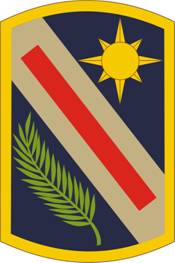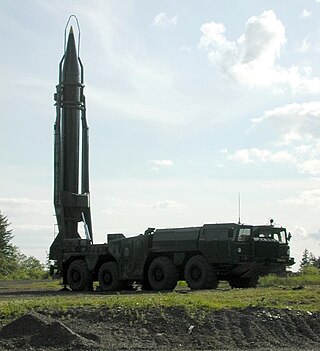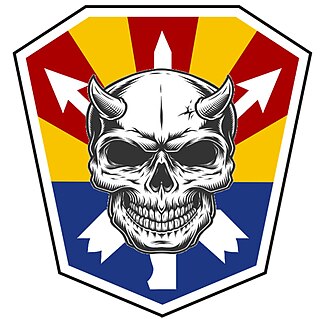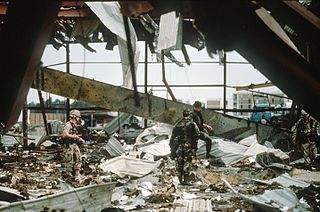Related Research Articles

The Gulf War was an armed conflict between Iraq and a 42-country coalition led by the United States. The coalition's efforts against Iraq were carried out in two key phases: Operation Desert Shield, which marked the military buildup from August 1990 to January 1991; and Operation Desert Storm, which began with the aerial bombing campaign against Iraq on 17 January 1991 and came to a close with the American-led liberation of Kuwait on 28 February 1991.

The 80th Training Command is a formation of the United States Army Reserve.

The 99th Infantry Division briefly existed, but never deployed, in the closing days of World War I, was reconstituted as a reserve unit in 1921, was ordered into active military service in 1942, and deployed overseas in 1944. The 99th landed at the French port of Le Havre and proceeded northeast to Belgium. During the heavy fighting in the Battle of the Bulge, the unit suffered many casualties, yet tenaciously held its defensive position. In March 1945, the 99th advanced into the Rhineland, crossing the Rhine River at Remagen on March 11. After fighting in the Ruhr area, the unit moved southward into Bavaria, where it was located at the end of the war.

The Battle of Khafji was the first major ground engagement of the Gulf War. It took place in and around the Saudi Arabian city of Khafji, from 29 January to 1 February 1991.

The 4th Marine Division is a reserve division in the United States Marine Corps. It was raised in 1943 for service during World War II, and subsequently fought in the Pacific against the Japanese. Deactivated after the war, the division was re-formed in 1966 and elements of the division deployed during the Gulf War in 1990–1991, as well as during the Iraq War. It is currently the ground combat element of the Marine Forces Reserve and is headquartered in New Orleans, Louisiana, and has units throughout the United States.

The United States Army Quartermaster Corps, formerly the Quartermaster Department, is a sustainment and former combat service support (CSS) branch of the United States Army. It is also one of three U.S. Army logistics branches, the others being the Transportation Corps and the Ordnance Corps.

The 14th Marine Regiment is a reserve artillery regiment of the United States Marine Corps consisting of three artillery battalions and a headquarters battery. The regiment is based in Fort Worth, Texas however its units are dispersed among 15 different sites in 12 states. Its primary weapon system is the M777A2 Howitzer with a maximum effective range of 30 km however one of its battalions has converted to fire the High Mobility Artillery Rocket System (HIMARS) weapon system.

Dhahran is a city located in the Eastern Province, Saudi Arabia. With a total population of 143,936 as of 2022, it is a major administrative center for the Saudi oil industry. Together with the nearby cities of Dammam and Khobar, Dhahran forms part of the Dammam Metropolitan Area, which is commonly known as greater Dammam and has an estimated population of 2.2 million as of 2022.

The 321st Sustainment Brigade is a sustainment brigade of the United States Army Reserve.

Operation Vigilant Warrior was a military operation from 8 October 1994 to 15 December 1994 by the United States in response to two divisions of Iraqi Republican Guard troops moving toward the Kuwaiti border. A quick response by U.S. president Bill Clinton allowed USCENTAF command and staff to deploy to Riyadh within days.
The 68th Division Sustainment Support Battalion is a U.S. Army support battalion stationed at Fort Carson, Colorado. The battalion motto is "Stagecoach, LET'S GO". The 68th Division Sustainment Support Battalion's current call sign is "Stagecoach". The 68th DSSB has deployed overseas to India, Burma, Somalia, Cuba, Kuwait, Saudi Arabia, Iraq, and Afghanistan.

The 197th Infantry Brigade is an active Infantry brigade of the United States Army. The brigade was active as an Organized Reserve unit from 1921 to 1942, in the Regular Army from 1962 to 1991, and as a TRADOC training unit from 2007 to 2013. The brigade saw service in Operation Desert Storm with the 24th Infantry Division. On July 31, 2020, the brigade was activated as a training brigade in Fort Moore, Georgia, to serve the increased training needs of the army.

A Scud missile is one of a series of tactical ballistic missiles developed by the Soviet Union during the Cold War. It was exported widely to both Second and Third World countries. The term comes from the NATO reporting name attached to the missile by Western intelligence agencies. The Russian names for the missile are the R-11, and the R-17Elbrus. The name Scud has been widely used to refer to these missiles and the wide variety of derivative variants developed in other countries based on the Soviet design.

al-Husayn was a short-range ballistic missile developed in Ba'athist Iraq. An upgraded version of Scud missile, the al-Husayn was widely used by the Iraqi Army during the Iran–Iraq War (1980–1988) and the Persian Gulf War (1990–1991).

The 14th Military Police Brigade is a military police unit stationed at Fort Leonard Wood, in Missouri. The 14th Military Police Brigade provides the Army with Soldiers, DA Civilians, and leaders of character who provide the basic and advanced skills required to execute policing, detention, and security mobility support across the range of military operations.

Eugene E. Porterfield is a former member of the Pennsylvania State Senate, serving from 1989 to 1996. He is also a businessman.

The 3rd Medical Command (Deployment Support) (MCDS) or "Desert Medics" is headquartered in Atlanta, GA and manages all the Army Reserve deployable field medical units east of Ohio. While the 807th MCDS covers the MTOE medical units to the west and ARMEDCOM provides command and control for all the Table of Distribution and Allowance (TDA) medical units within CONUS.
The timeline of the Gulf War details the dates of the major events of the 1990–1991 war. It began with the Iraqi invasion of Kuwait on 2 August 1990 and ended with the Liberation of Kuwait by Coalition forces. Iraq subsequently agreed to the United Nations' demands on 28 February 1991. The ground war officially concluded with the signing of the armistice on 11 April 1991. However, the official end to Operation Desert Storm did not occur until sometime between 1996 - 1998. Major events in the aftermath include anti-Saddam Hussein uprisings in Iraq, massacres against the Kurds by the regime, Iraq formally recognizing the sovereignty of Kuwait in 1994, and eventually ending its cooperation with the United Nations Special Commission in 1998.

3666th Support Maintenance Company "Desert Demons" is a maintenance and support company that is task organized to provide maintenance support operations to battalion level or higher elements including special operations. The 3666th SMC is currently stationed at Petty Crew Armory, Papago Park Military Reservation, Arizona, and is a subordinate unit of the 158th Combat Sustainment Support Battalion, 198th Regional Support Group, Arizona Army National Guard.

Between 18 January and 26 February 1991, Ba'athist Iraq launched 46 al-Husayn Scud missiles against Saudi Arabian and American military targets in Dhahran and the Saudi capital of Riyadh amidst the Gulf War. Attacks began hours after US General Norman Schwarzkopf emphasized large-scale efforts taken to comb the vast expanses of western Iraq for missile attacks aimed at Israel.
References
- ↑ Higham, Nicholas J (1996). Accuracy and stability of numerical algorithms. SIAM, p. 506. ISBN 0-89871-355-2